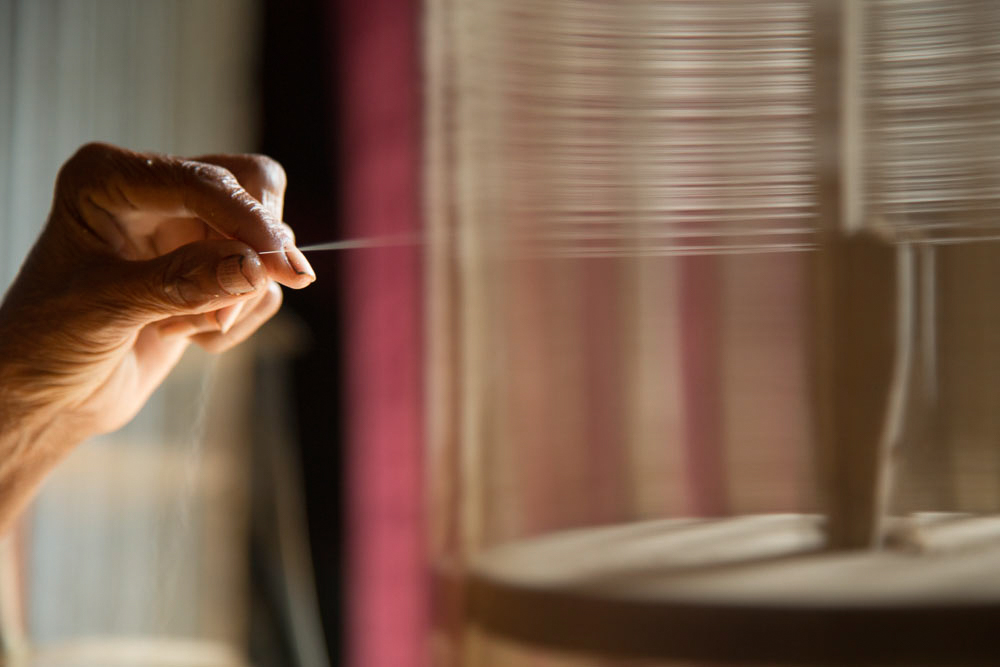
High count yarn, above three hundred, is processed and spun in readiness before the final stage of weaving in Rupganj, Bangladesh. Tapash Paul, Drik-Bengal Muslin, Bangladesh.
Saiful Islam describes the delicate gestures involved in the production of Bangladesh’s ethereal textile.
(A message to the reader.)
When is a “feel” “not a feel”? Are our senses the guardians of another’s existence, gatekeepers of our reality, authenticating external objects? If we do not perceive things through touch, sight and smell, do they not exist? How do we define the texture of air, the taste of water or the flow of the wind? When do our nerves give up and quit, saying this is beyond the scale of their measurement, on the very edge of our sensibilities and receptors? Our nervous system is well mapped and capable of instantly locating where on the body something is touching us. And yet, can something be made that dares to bypass something as sensitive, as archival as the inbuilt memory of this age-old system which would normally remember the lightest to the heaviest item?
Almost a decade ago, while managing Drik (an activist, image library company based in Bangladesh) I had been approached in the UK by Stepney Trust, an East End culture organisation, to take their muslin exhibition to Dhaka (the capital of Bangladesh). But we wanted to know more than what they displayed, and thus our journey started, as Bengal Muslin.
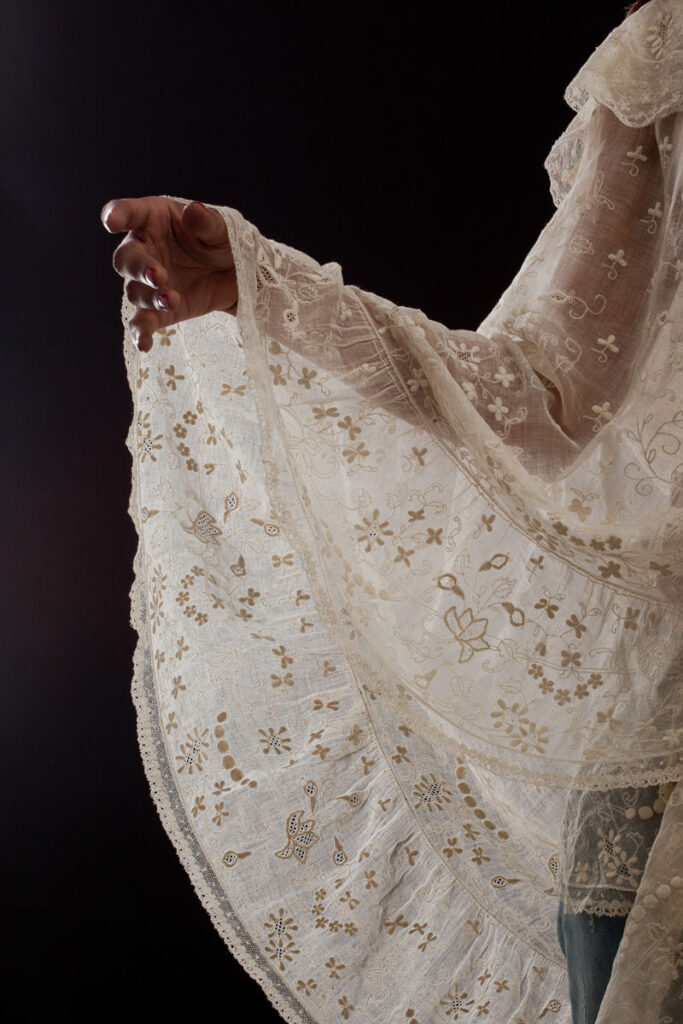
An 18th century Bengal muslin stole, embroidered in Dresden, Germany for the European market is modelled for an exhibition held in Bangladesh. Tapash Paul, Drik-Bengal Muslin, Bangladesh.
The muslin of ancient East Bengal (currently Bangladesh) was a fine white cotton cloth eons removed from the machine-milled, gauzy cloth we know today. Muslin made in Dhaka was of an unsurpassed fineness, ranging between an astonishing 300-1200 thread count (defined as one thousand meters weighed in grams; thus two grams translates to five hundred count). The source of this muslin is a unique cotton plant (locally known as phuti karpas, scientifically as Gossypium Arboreum Var. Neglecta) that grew only on a particular stretch of the Meghna river. The inhabitants of the surrounding areas, over millennia, developed the complex and specialized skills needed to plant and harvest the phuti karpas, spin its fibres into an ultrafine yarn, and weave it on the traditional pit handloom to produce Dhaka’s famed muslin. Enchanted by the fabric, the Mughals commissioned the production of a variety of the unique, diaphanously fine muslin for the sole use of the royal family (called mul mul khas) while other varieties were traded to domestic and international courts. Bengal’s coffers were filled to the brim with Europe’s wealth. But it all ended when British colonial rule, in the form of the East India Company (1757 to 1858), with its punitive taxes and a captive market for its cheap, machine-made Lancaster cotton, utterly destroyed Bengal’s handloom cotton industry, and with it, Dhaka muslin. As generations passed, phuti karpas, along with their attendant yarn-spinning and weaving skills, were irretrievably lost. Only jamdani, a “figured and flowered” muslin has survived to modern times, albeit in a coarser form.
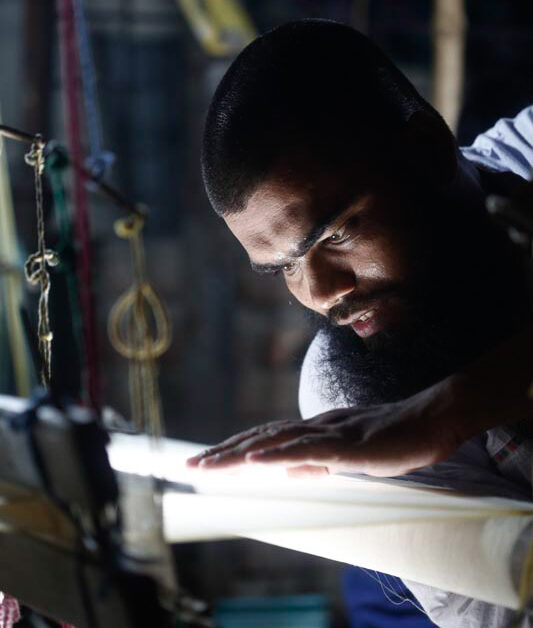
A master weaver touches the warp on the loom, testing its taughtness while weaving ‘new muslin’ in Rupganj, Bangladesh. Tapash Paul, Drik-Bengal Muslin, Bangladesh.
Our challenge was to retrace the past, armed with the hereditary senses and knowledge of the spinners and weavers as our best guide. Today’s callipers, balances and spectrometers can measure the magic but not imagine or create it.
“Muslin – what myth does the name hold? What mystery lies behind the filaments of this fabric? Who wove it? Who wore it? To look upon it today is to look upon a discarded rag, off-white, slightly awry, studded with floral patterns in many cases, plain or at best a golden edging. Was this the start of the ‘wannabe’ culture that continues with the Diors of today?”
Phuti karpas’s cotton was biannual (unlike all other varieties, which are annual) growing both as a winter and a summer crop, the latter flowering during the monsoon season. Where most cotton would spoil during the rains, phuti karpas would thrive, and even become stronger when soaked in water. Its filaments, unlike those of regular cotton, revealed under the microscope not a round shape but a flat one. Its fibers were unusually silky and too short for spinning machines and thus were spun by hand, using the takwa (a vertical spindle). The winter crop produced lower yields but finer filaments. And of that cotton, the filaments nearest to the seed were the shortest and the finest, the most difficult to separate. These produced the best yarn and were used for the incomparable mul-mul khas, fit for Mughal aesthetic standards. From a crop that was hard to cultivate in the first place and had only eight (yes, eight!) per cent usable cotton, the finest yarn would be only a third of this eight per cent.
…their fingertips like eyes “seeing” their way to the root of the fibers.
Extracting the cotton filaments from the phuti karpas plant was an extraordinarily delicate task. They were tightly bound to the seeds, and my fingers would ache since I had to pull them gently, relying on a steady but blunt touch. The fibers clung like a child to a mother’s hand, reluctant to part from the brown surface of their birth. But the female spinners did the task nonchalantly, their fingertips like eyes “seeing” their way to the root of the fibers. Touch guided them, as machines would damage this unique cotton’s children if they were roughly separated from their shelters. When enough karpas (raw cotton) had been collected, the ginning (dhun, in Bangla) was done with a small hand-held bow. Here, touch was now deemed too rough and only a gentle strumming above the cotton pile would separate the lightest of the fibers from the heaviest. Finally, the tula (cleaned cotton) was ready for its first transformation into the desired yarn.
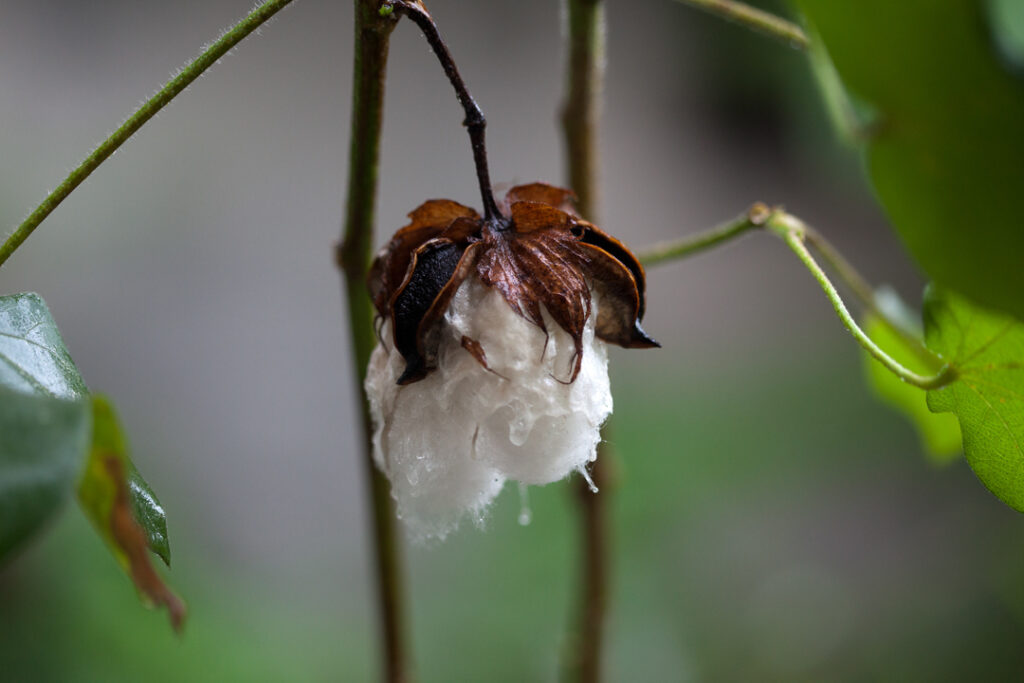
New ‘phuti karpas’ cotton bursting from its pod, cultivated on the banks of the river Sitalakhya in Bangladesh. Habibur Rahman, Drik-Bengal Muslin, Bangladesh.
Go ahead, take a small clutch of cotton in one hand, wrapped in the skin of the kuchea (an eel-like fish from Bengal’s rivers) to keep it moist and clean. Touch it to the tip of the needle being rotated on the spindle by the other hand and pull – evenly and fast, for the faster you pull the finer the yarn. A three-hundred count is near to human hair; a twelve-hundred would be four times finer. Consistent humidity, enormous concentration and a fencer’s hand-eye coordination are required, all the while bobbing on a moored boat in the river, to provide the necessary moisture in the air. If the yarn was too thick or thin, touch again would reveal it to the seller and the eyes would confirm it, for the yarn’s price in the aarongs (markets, in Bangla) was far more than its weight in silver.

New muslin yarn of high count, tied on the loom after passing through the fine shana (reed) used for its weaving, in Rupganj, Bangladesh. Tapash Paul, Drik-Bengal Muslin, Bangladesh.
Another half a dozen steps of processing would follow and the pure cotton yarn, thinner than an impressionist’s white line, was ready for the loom. Two weavers sit, an ustad (master) on the right and a shagrid (apprentice) on the left, their feet operating the heddles (foot pedals) which connect the reed to the yarn while their hands flick and catch the maku (wooden shuttle with the weft thread) as it travels across the width of the warp. They weave a supplementary weft thread for the motifs on the body of the cloth and feel the cloth regularly with the palm of the hand, its tautness a litmus test for the quality of the weave: too little and the design sags, too much and the threads snap. After over one hundred thousand to-and-fros of the maku, a standard six-meter length of sari (dress Bengali women wear, wrapped around the body and one end covering a shoulder) is complete, ready to be appreciated, sold and gifted.
“Clothing in some form, texture and pattern has been with us for centuries. Textiles have been spun, embroidered, shaped and draped across the shoulders of common people and royalty in every culture. We all know that more intricate designs have been printed or spun into the body of a cloth, grander tapestries have hung, richer silk has been spun. After all, muslin was simply cotton, fine and fragile which most Mughals discarded after a day’s wear, diaphanous and see through (the Emperor Aurangzeb chiding his daughter for wearing see through clothes, while she actually wore seven layers), providing neither strong shelter from the weather nor an effective barrier to unwanted gazes. Tedious to make and almost impossible to hold, a full dress was beyond a measurable weight, the final product rare and only fit for supreme leisure and little else.”
Early in Driks journey, till about 2015, I had seen some varieties of border-line muslin (two- to three-hundred count) and was rather unimpressed. They appeared plain and unremarkable, in contrast to their rival velvets and silks. I wondered why the Grand Exhibition of 1851 in London had newspapers of the day waxing lyrical about it (“the work of fairies” said one article) and why they had outpriced all other textiles. I heard of a private collection of fine muslins in Kolkata, India, and a few months later was in the living room of the owner’s house. Over twenty pieces were brought out of approximately six-hundred count each, mostly plain yardage, each appearing as a shimmer of white in the soft lamp light. I placed my hand beneath the cloth, my palm lines clearly visible through them, but with my eyes shut could not detect their weight on my hand. For a long moment, it seemed I held not an earthly product but an artisan’s prayer. It was special.
“Perhaps herein lies its allure, the arachnidan pattern, the interwoven threads providing little else but an illusion of protection, a feeling against the skin, the perpetual caress of cloth, like “a second skin, the skin of the moon” (said by Abul Hasan Yamin ud-Din Khusrau, Indo-Persian poet and scholar, 1253-1325), its reality was an illusion in texture. To hold it, touch it, gaze upon it, is to be transported into a timeless past, where the sheen of antiquity on the soft cloth is heightened by a luminescent after-glow.”
The paucity of information, the lack of visible products, and the extinction of the plant and the produce by the English East India Company served to challenge our Bengal Muslin team to research and attempt a revival. In 2016, we had the first DNA-confirmed plant closest to the phuti karpas (a 70 per cent match), yarns of three hundred count and three saris ready for exhibition.
Finally, our team’s persistence and the resilient and inherent skill of the farmers and weavers had yielded a fabric closest to the one produced in its fabled past.
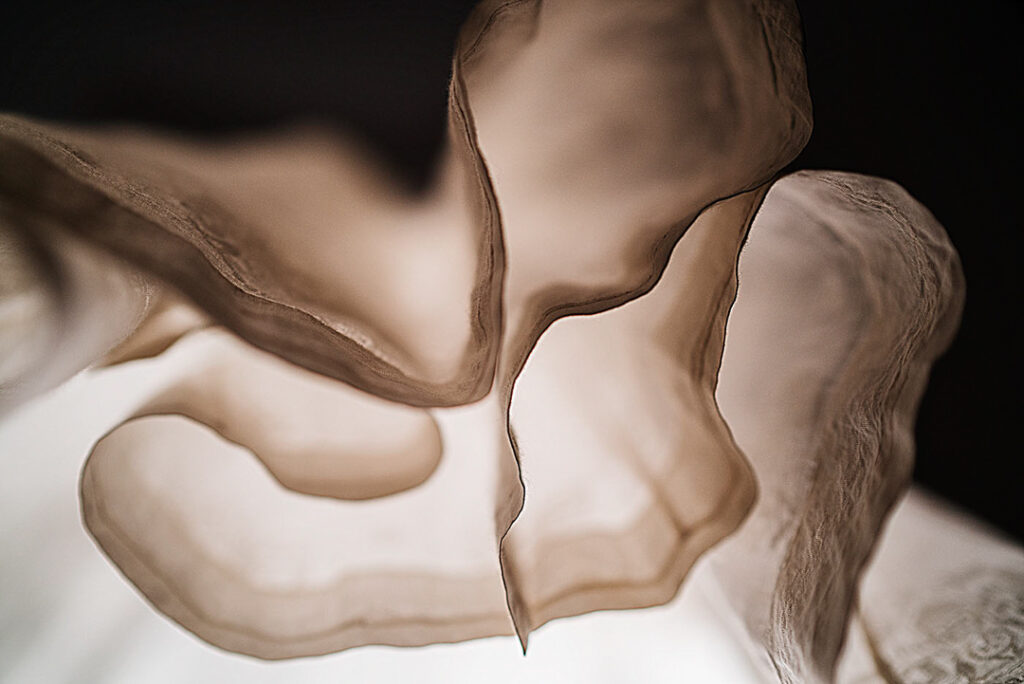
Antique Bengal muslin, 18th century yardage, reflects the ambient light as it basks in its glow. Shahidul Alam, Drik, Bangladesh.
Quotes are taken from Saiful Islam, Muslin. Our Story, Preface, published by Drik PL, 2016
About Saiful Islam
 Saiful Islam is a Bangladeshi whose background is in Engineering and Business Administration. He worked with various multinationals for 33 years in different countries, prior to retiring in 2013. He has published the book Muslin. Our Story and produced the film Legend of the Loom. He continues to research the topic, working with craftspeople in Bangladesh. He is currently the MD of Majority World and Bengal Muslin. He is married and has two children. (This photograph was taken through a yardage of 18th-century Bengal muslin.)
Saiful Islam is a Bangladeshi whose background is in Engineering and Business Administration. He worked with various multinationals for 33 years in different countries, prior to retiring in 2013. He has published the book Muslin. Our Story and produced the film Legend of the Loom. He continues to research the topic, working with craftspeople in Bangladesh. He is currently the MD of Majority World and Bengal Muslin. He is married and has two children. (This photograph was taken through a yardage of 18th-century Bengal muslin.)


Comments
Loved the article, Muslin fascinates me, always has.
Where could I buy the book?